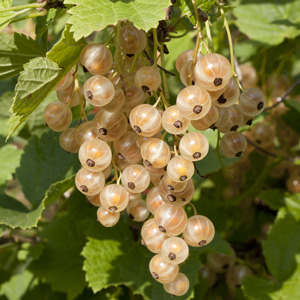White Currant Growing Guide

What is White Currant?
White currant (Ribes sativum) is an upright small sized deciduous shrub that fruits mid Summer. Part of the Grossulariaceae family which include the other currants and gooseberry, the white currant originated in Northern Europe. The white currant shrub will grow vigorously in its first year and then flower and fruit the second year however sometimes it may take up to 5 years to mature and bear fruit. Multiple branches of these small bushes produce a multitude of flowers which are coloured pale yellow that develop into small pale white glossy berries. White currants commence ripening in mid Summer. Best grown in areas with a cold Winter as a ‘chilling period’ will assist fruit set. White currants prefer a full sun position and grows best when given shelter from strong hot winds. They like rich well drained soil. Marigolds can be planted with them as companion plants.
Benefits of Growing White Currant
White currants have a very sweet with a slightly sour flavour and are very high in vitamin C. They are best used for making jams, juice and in cooking. They are a fantastic natural concentrated source of vitamin C and antioxidants.
How to Grow White Currant
Climatic Zones
Cool, temperate, arid.
Plant Size
Height: 1m, Width: 60cm
When To Plant White Currant
Plant in Autumn to early Winter to allow establishment before Spring.
Soil Preparation
They like a rich, well drained soil. Dig through plenty of organic matter or well broken down animal manure before planting. Spread a complete fertiliser also.
How To Plant White Currant
Plant in full sun, 1.5m apart with the plant crown at soil level.
White Currant Plant Care
For optimum fruit production canes need to be kept well watered. Will benefit from mulching in Spring to conserve moisture in Summer and keep roots cool.
White currants like to be fed. Sprinkle with general fertiliser each Spring and top dress with well broken down animal manure or compost.
Pruning should be done in Winter. Leave between eight and ten healthy, strong main branches each year. The ideal bush shape is an open ‘goblet’ with a single main stem and an open space inside the bush to allow light in and to aid air circulation. On one year old bushes, prune back new shoots by half. Prune to an outward facing bud to influence the direction that the new shoot will grow. You want the middle of the plant to remain open so that air can flow to prevent disease. If the branch is low to the ground, an upward facing bud is a better choice. The following winter, shorten new leading shoots by half. Once they’ve reached full size or reached the size that you require, pruning becomes simpler. Each year, prune all the previous year’s growth back to a single bud. Remove any branches that have become unproductive, and replace them with a new shoot that will help to keep the shape of the bush. Remove any branches that hang low to the ground, as the fruits on these may rot or be eaten by pests
Currants are generally trouble free, however aphids and red spider mites should be watched for. Birds will be your main problem during fruiting time so you can place a net over your canes to prevent birds eating your berries.







